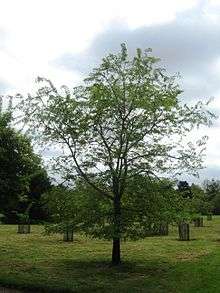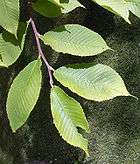Ulmus szechuanica
Ulmus szechuanica Fang, known as the Szechuan (Sichuan), or red-fruited, elm, is a small to medium deciduous Chinese tree found along the Yangtze river through the provinces of Sichuan, Jiangxi, Anhui, and Jiangsu.
| Ulmus szechuanica | |
|---|---|
 | |
| Ulmus szechuanica, Sir Harold Hillier Gardens | |
| Scientific classification | |
| Kingdom: | Plantae |
| Clade: | Tracheophytes |
| Clade: | Angiosperms |
| Clade: | Eudicots |
| Clade: | Rosids |
| Order: | Rosales |
| Family: | Ulmaceae |
| Genus: | Ulmus |
| Species: | U. szechuanica |
| Binomial name | |
| Ulmus szechuanica Fang | |
| Synonyms | |
| |
Description

The tree can reach a height of 18 m, but is usually less than 10 m, with a spreading umbrella-like crown. The leaves, dark red on emergence, are generally obovate < 9 cm long by 5 cm broad, borne on branchlets with an irregular corky layer. The wind-pollinated apetalous flowers are produced on second-year shoots in February, followed in March by suborbicular samarae < 16 mm long by 13 mm wide.[1][2]
Pests and diseases
Ulmus szechuanica was evaluated with other Chinese elms at the Morton Arboretum, Illinois, where it exhibited a resistance to Dutch elm disease. The species is eschewed by the Elm Leaf Beetle Xanthogaleruca luteola.[3][4]
Cultivation
Growing best on well-drained soils, U. szechuanica is cold hardy; in artificial freezing tests at the Morton Arboretum [5] the LT50 (temp. at which 50% of tissues die) was found to be −30 °C. However, it was also found to be comparatively weak-wooded, making it susceptible to storm damage in winter.[6] There are no known cultivars of this taxon, nor is it known to be in commerce beyond the United States.
Hybrid cultivars
U. szechuanica is believed to have been used in post-2000 hybridization experiments at the Morton Arboretum.[7]
Accessions
- North America
- Brenton Arboretum, Iowa, US. No accession details available.
- Chicago Botanic Garden, Illinois, US. 2 trees, no other details available.
- Denver Botanic Gardens, US. No details available
- Holden Arboretum, US. Acc. nos. 96-179 (unknown provenance), 97-30 wild collected in China.
- Morton Arboretum, US. Acc. nos. 429-84, 53-95.
- United States National Arboretum Washington, D.C., US. Acc. nos. 68987, 68991, 76235, 76236, 76250, 68992.
- Europe
- Grange Farm Arboretum, Lincolnshire, UK. Acc. no. 523
- Sir Harold Hillier Gardens, Hampshire, UK. Acc. no. 1994.0329, one tree, 4.4 m tall in 2008, from seed from the Shanghai Botanical Garden
Nurseries
- North America
- Sun Valley Garden Centre , Eden Prairie, Minnesota, US.
- Europe
- Pan-Global Plants , Frampton-on-Severn, Gloucestershire, UK.
References
- Fu, L. & Jin J. (eds). (1992). China Red Data Book. Rare and endangered plants. Vol. 1. Science Press, Beijing.
- Fu, L., Xin, Y. & Whittemore, A. (2002). Ulmaceae, in Wu, Z. & Raven, P. (eds) Flora of China, Vol. 5 (Ulmaceae through Basellaceae). Science Press, Beijing, and Missouri Botanical Garden Press, St. Louis, USA.
- Miller, F. & Ware, G. (1884). Preference for and Suitability of Selected Elms Ulmus spp. and their Hybrids for the Elm Leaf Beetle, (Pyrrhalta luteola Coleoptera: Chrysomelidae). Journal of Environmental Horticulture. 12(4):231 - 235. December 1994.
- "Elm Leaf Beetle Survey". Archived from the original on 2011-07-19. Retrieved 17 July 2017.
- Shirazi, A. M. & Ware, G. H. (2004). Evaluation of New Elms from China for Cold Hardiness in Northern Latitudes. International Symposium on Asian Plant Diversity & Systematics 2004, Sakura, Japan.
- Ware, G. (1995). Little-known elms from China: landscape tree possibilities. Journal of Arboriculture, (Nov. 1995). International Society of Arboriculture, Champaign, Illinois, US. Archived 2007-11-30 at the Wayback Machine
- Mittempergher, L. & Santini, A. (2004). Elm breeding history. Invest Agrar: Sist Recur For, (2004), 13 (1), 161-177.